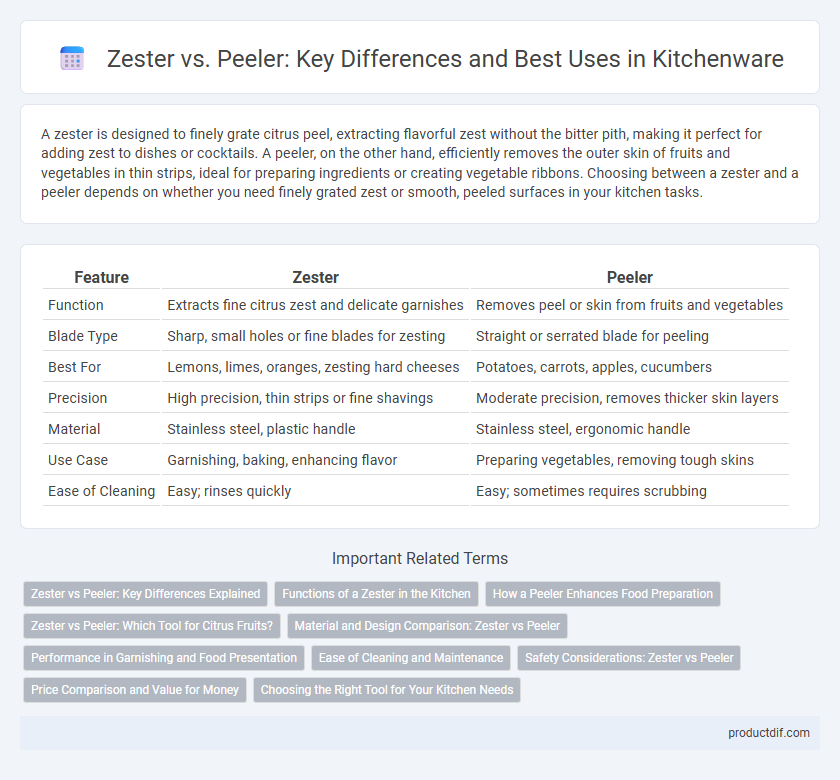A zester is designed to finely grate citrus peel, extracting flavorful zest without the bitter pith, making it perfect for adding zest to dishes or cocktails. A peeler, on the other hand, efficiently removes the outer skin of fruits and vegetables in thin strips, ideal for preparing ingredients or creating vegetable ribbons. Choosing between a zester and a peeler depends on whether you need finely grated zest or smooth, peeled surfaces in your kitchen tasks.
Table of Comparison
| Feature | Zester | Peeler |
|---|---|---|
| Function | Extracts fine citrus zest and delicate garnishes | Removes peel or skin from fruits and vegetables |
| Blade Type | Sharp, small holes or fine blades for zesting | Straight or serrated blade for peeling |
| Best For | Lemons, limes, oranges, zesting hard cheeses | Potatoes, carrots, apples, cucumbers |
| Precision | High precision, thin strips or fine shavings | Moderate precision, removes thicker skin layers |
| Material | Stainless steel, plastic handle | Stainless steel, ergonomic handle |
| Use Case | Garnishing, baking, enhancing flavor | Preparing vegetables, removing tough skins |
| Ease of Cleaning | Easy; rinses quickly | Easy; sometimes requires scrubbing |
Zester vs Peeler: Key Differences Explained
A zester features fine, sharp holes to extract thin strips of citrus peel, enhancing flavor without bitterness, while a peeler removes thicker layers of skin from fruits and vegetables for cooking or presentation. Zesters are ideal for zesting lemons, limes, and oranges, enabling the capture of aromatic oils, whereas peelers efficiently strip potatoes, carrots, and apples to prepare them for recipes. Choosing between a zester and peeler depends on the culinary need: zesting for flavor enhancement or peeling for ingredient preparation.
Functions of a Zester in the Kitchen
A zester is designed to finely grate citrus fruit peel, extracting flavorful zest without the bitter white pith. It produces delicate, aromatic zest ideal for enhancing recipes like baked goods, sauces, and cocktails. Unlike a peeler, which removes larger strips of skin, a zester's sharp, small holes create fine, consistent shreds perfect for precise flavor infusion.
How a Peeler Enhances Food Preparation
A peeler enhances food preparation by efficiently removing thin layers of skin from fruits and vegetables, preserving the nutrient-rich flesh beneath. Its ergonomic design and sharp blade reduce prep time and minimize food waste compared to other tools. Using a peeler ensures consistent slicing thickness, improving both the texture and presentation of dishes.
Zester vs Peeler: Which Tool for Citrus Fruits?
A zester excels at extracting fine, fragrant citrus zest, capturing the fruit's essential oils ideal for baking and garnishing, while a peeler efficiently removes thicker, larger citrus peels perfect for candying or infusing. Zesters typically have sharp, narrow holes to create thin strips of zest, preserving the bitter white pith, whereas peelers shave off wider strips including more pith, which may affect flavor. Choosing between a zester and peeler depends on the desired texture and intensity of citrus flavor in culinary applications.
Material and Design Comparison: Zester vs Peeler
Zesters typically feature stainless steel blades with fine, sharp edges designed for zesting citrus fruits, while peelers use slightly broader, sometimes serrated blades for removing vegetable and fruit skins. The handle materials vary from plastic to wood or rubberized grips, with peelers often prioritizing ergonomic designs for repetitive peeling tasks. Zesters emphasize precision with narrow slots or holes to finely grate zest, whereas peelers focus on durability and blade flexibility to efficiently handle tougher skins.
Performance in Garnishing and Food Presentation
A zester excels in finely grating citrus zest and hard cheeses, creating delicate, visually appealing garnishes that enhance food presentation with vibrant texture and aroma. Peelers efficiently remove thin layers of fruits and vegetables, producing long, uniform strips ideal for decorative ribbons and intricate garnishes. The choice between a zester and peeler directly impacts the precision and aesthetic quality of garnishing in culinary plating.
Ease of Cleaning and Maintenance
Zesters feature narrow, sharp holes that can trap small bits of zest, requiring careful rinsing and occasional use of a brush for thorough cleaning. Peelers have wider blades and simpler designs, making them easier to rinse under running water and less prone to residue buildup. Both kitchen tools benefit from stainless steel materials for durability and ease of maintenance.
Safety Considerations: Zester vs Peeler
Zesters feature fine, sharp edges designed to grate citrus zest, requiring careful handling to avoid cuts, especially when used without protective gloves. Peelers typically have a retractable blade with a safety guard, reducing the risk of injury during routine peeling tasks. Choosing a peeler with an ergonomic, non-slip handle enhances control and further minimizes accidents compared to the more exposed blades of zesters.
Price Comparison and Value for Money
Zesters generally cost between $5 and $15, offering precise zesting capabilities ideal for citrus-based recipes, while peelers range from $3 to $20, providing versatile use for fruits and vegetables. Considering value for money, a peeler delivers multifunctional benefits, making it a practical choice for everyday kitchen tasks. However, for specialized baking or cocktail preparation, investing in a quality zester enhances flavor extraction and presentation.
Choosing the Right Tool for Your Kitchen Needs
Selecting between a zester and a peeler depends on the intended kitchen tasks and desired outcomes. A zester excels at finely grating citrus zest, enhancing recipes with aromatic oils, while a peeler efficiently removes thin layers of skin from fruits and vegetables for preparation or presentation. Assess your cooking habits and recipe requirements to determine which tool enhances your culinary efficiency and flavor profiles.
Zester vs Peeler Infographic

 productdif.com
productdif.com